MG413 Presentation: Data Insights in Business Decisions 2021-22
VerifiedAdded on 2023/06/11
|11
|1031
|332
Presentation
AI Summary
This presentation provides an overview of data insights in business decisions, focusing on the types of data collected and used in the hospitality industry, contrasting orthodox market research with big data, and explaining how information is captured. It also discusses the impact of technological development on decision-making and illustrates the use of data and information with examples from the hospitality sector, such as Premier Inn. The presentation concludes by outlining strategies for enhancing data capturing and emphasizing the importance of customer relationship management. This resource is useful for students seeking examples and insights into data-driven decision-making in business.
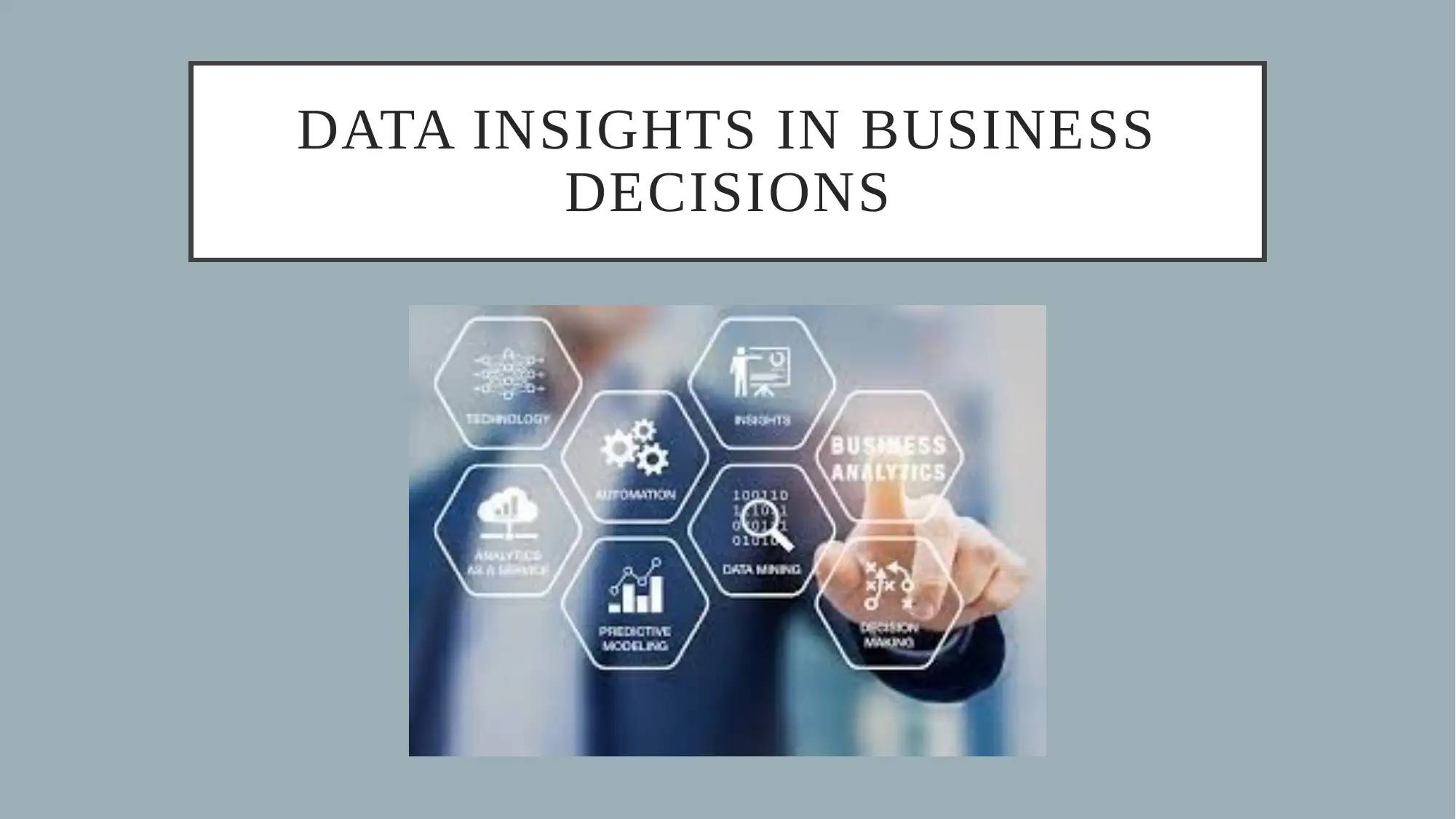
DATA INSIGHTS IN BUSINESS
DECISIONS
DECISIONS
Paraphrase This Document
Need a fresh take? Get an instant paraphrase of this document with our AI Paraphraser
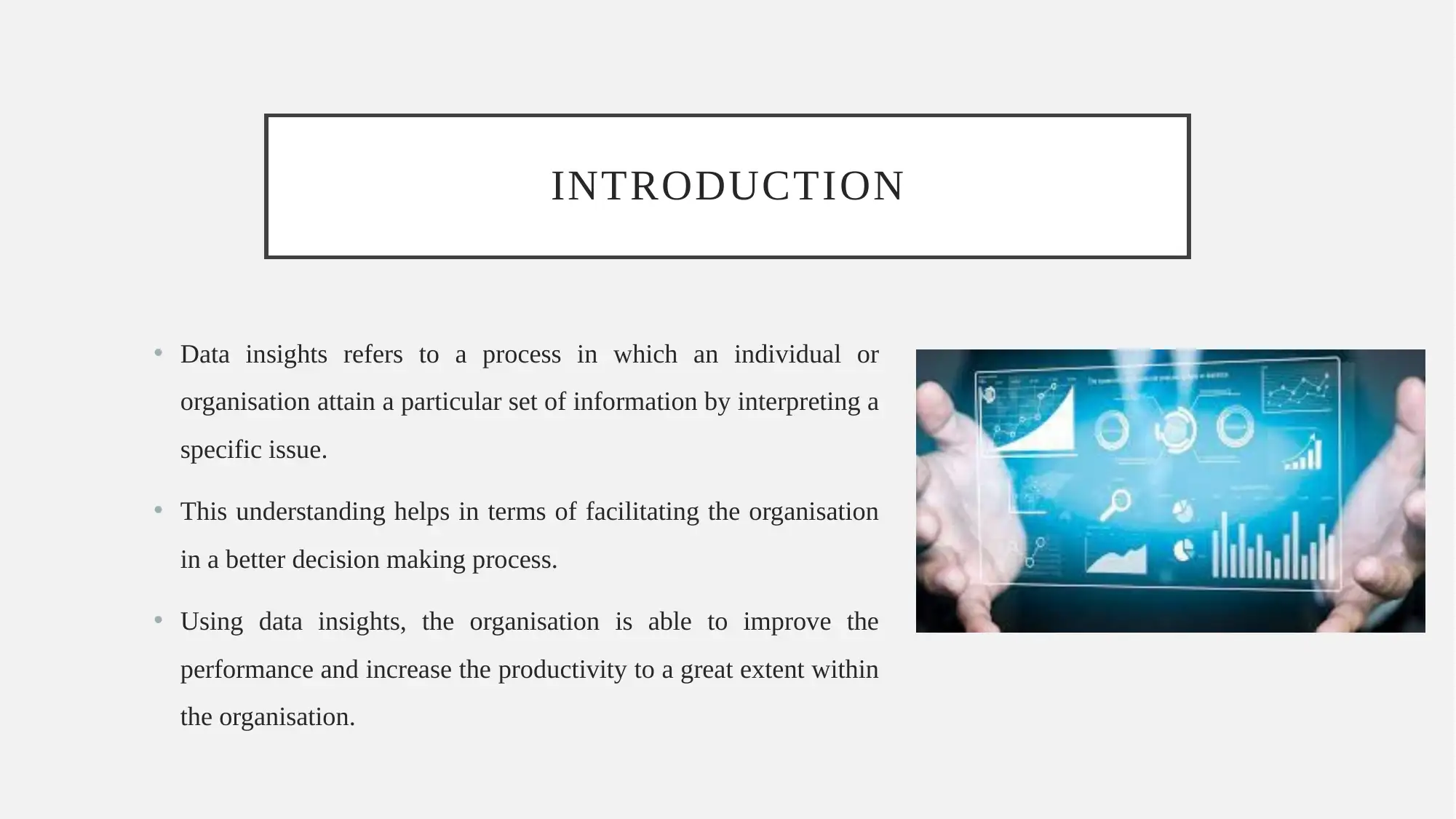
INTRODUCTION
• Data insights refers to a process in which an individual or
organisation attain a particular set of information by interpreting a
specific issue.
• This understanding helps in terms of facilitating the organisation
in a better decision making process.
• Using data insights, the organisation is able to improve the
performance and increase the productivity to a great extent within
the organisation.
• Data insights refers to a process in which an individual or
organisation attain a particular set of information by interpreting a
specific issue.
• This understanding helps in terms of facilitating the organisation
in a better decision making process.
• Using data insights, the organisation is able to improve the
performance and increase the productivity to a great extent within
the organisation.
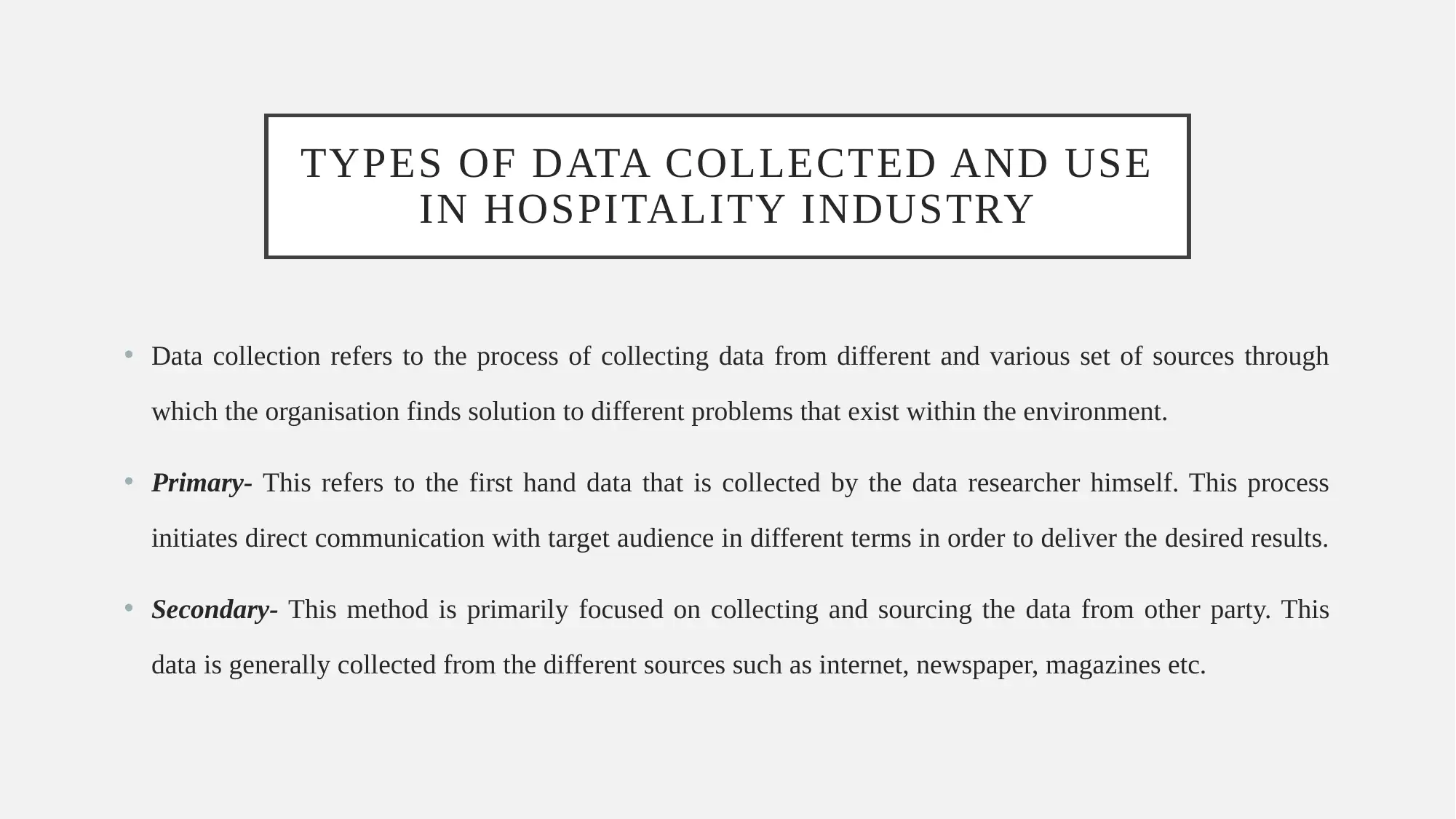
TYPES OF DATA COLLECTED AND USE
IN HOSPITALITY INDUSTRY
• Data collection refers to the process of collecting data from different and various set of sources through
which the organisation finds solution to different problems that exist within the environment.
• Primary- This refers to the first hand data that is collected by the data researcher himself. This process
initiates direct communication with target audience in different terms in order to deliver the desired results.
• Secondary- This method is primarily focused on collecting and sourcing the data from other party. This
data is generally collected from the different sources such as internet, newspaper, magazines etc.
IN HOSPITALITY INDUSTRY
• Data collection refers to the process of collecting data from different and various set of sources through
which the organisation finds solution to different problems that exist within the environment.
• Primary- This refers to the first hand data that is collected by the data researcher himself. This process
initiates direct communication with target audience in different terms in order to deliver the desired results.
• Secondary- This method is primarily focused on collecting and sourcing the data from other party. This
data is generally collected from the different sources such as internet, newspaper, magazines etc.
⊘ This is a preview!⊘
Do you want full access?
Subscribe today to unlock all pages.

Trusted by 1+ million students worldwide
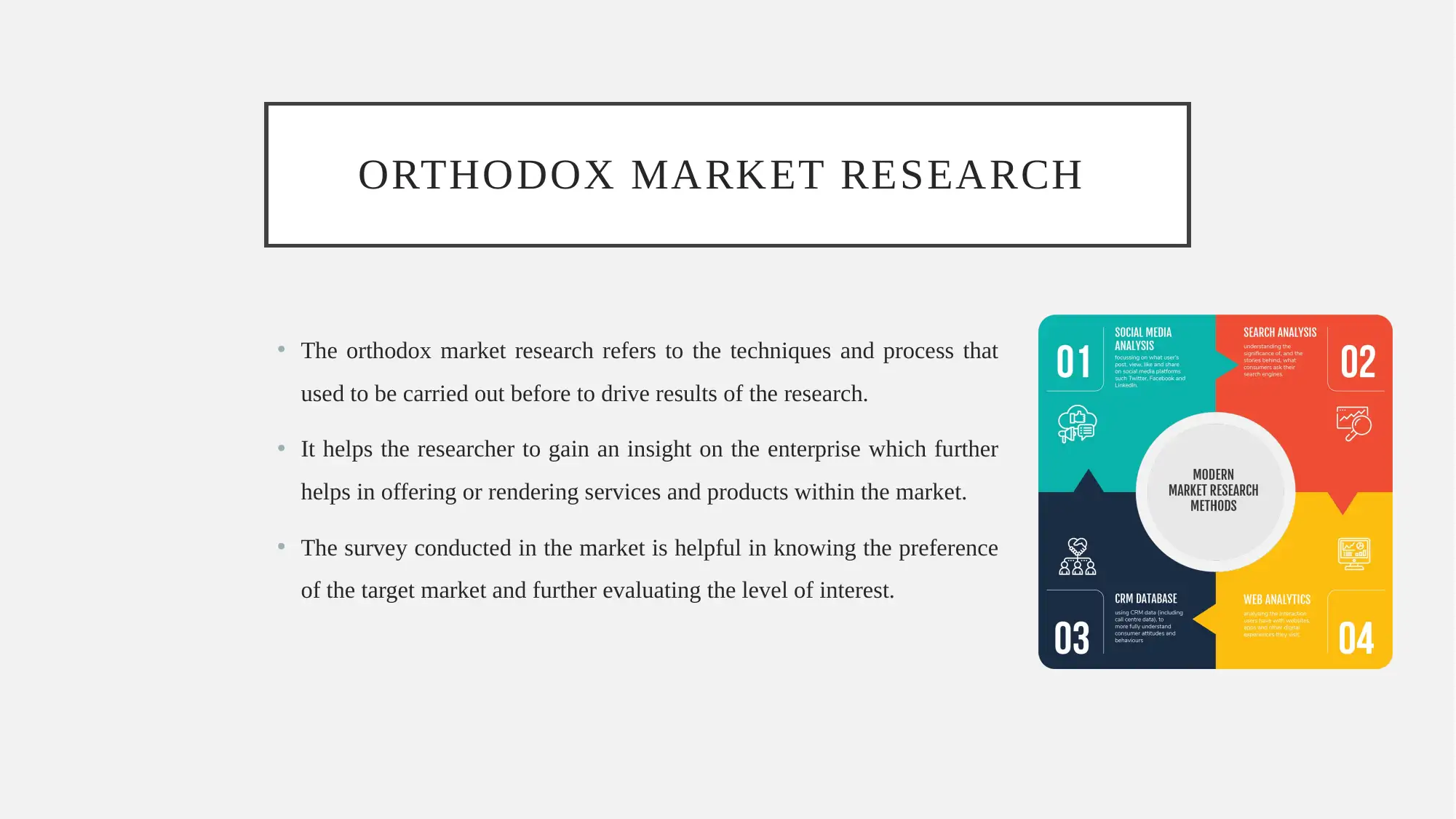
ORTHODOX MARKET RESEARCH
• The orthodox market research refers to the techniques and process that
used to be carried out before to drive results of the research.
• It helps the researcher to gain an insight on the enterprise which further
helps in offering or rendering services and products within the market.
• The survey conducted in the market is helpful in knowing the preference
of the target market and further evaluating the level of interest.
• The orthodox market research refers to the techniques and process that
used to be carried out before to drive results of the research.
• It helps the researcher to gain an insight on the enterprise which further
helps in offering or rendering services and products within the market.
• The survey conducted in the market is helpful in knowing the preference
of the target market and further evaluating the level of interest.
Paraphrase This Document
Need a fresh take? Get an instant paraphrase of this document with our AI Paraphraser
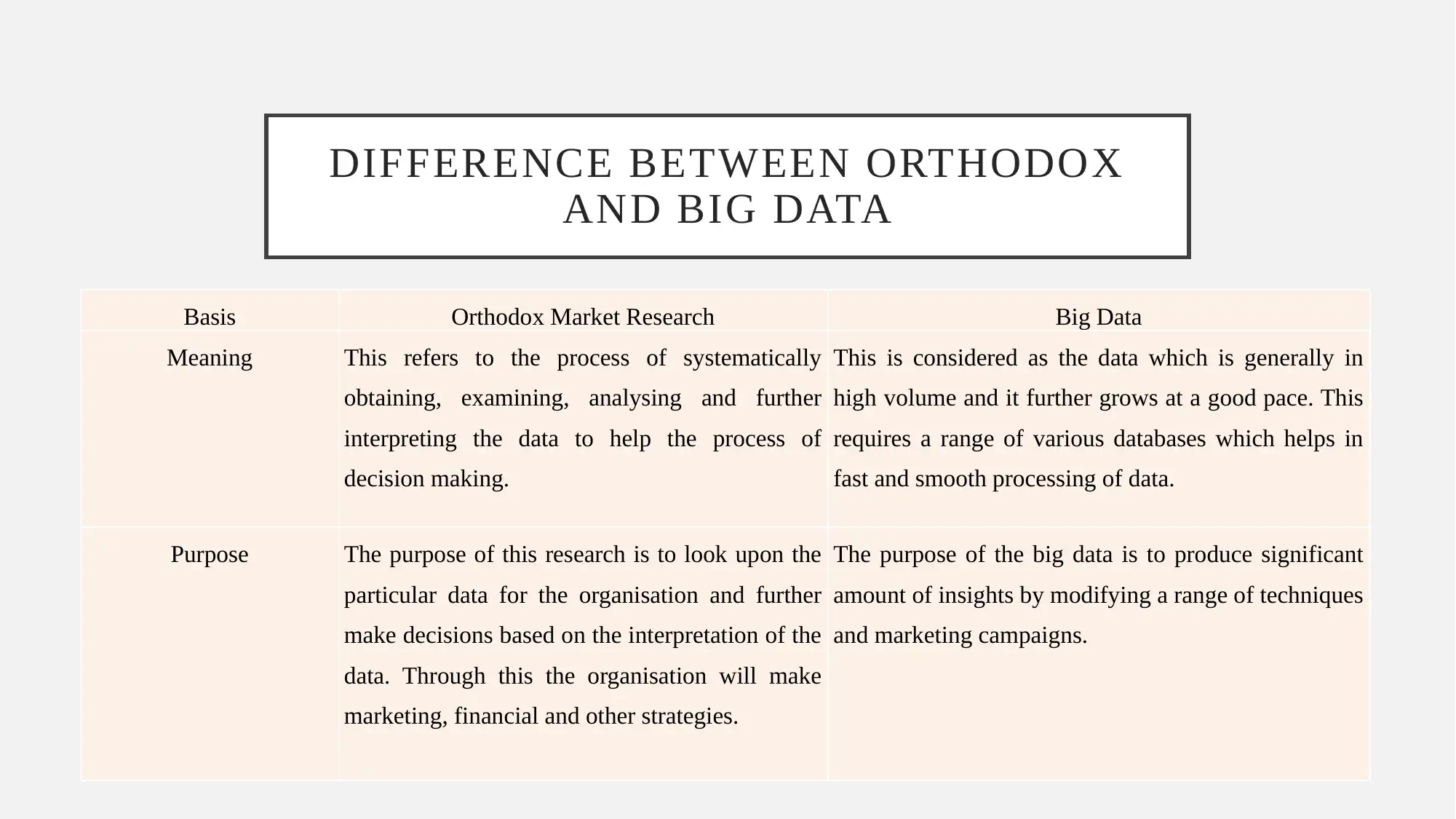
DIFFERENCE BETWEEN ORTHODOX
AND BIG DATA
Basis Orthodox Market Research Big Data
Meaning This refers to the process of systematically
obtaining, examining, analysing and further
interpreting the data to help the process of
decision making.
This is considered as the data which is generally in
high volume and it further grows at a good pace. This
requires a range of various databases which helps in
fast and smooth processing of data.
Purpose The purpose of this research is to look upon the
particular data for the organisation and further
make decisions based on the interpretation of the
data. Through this the organisation will make
marketing, financial and other strategies.
The purpose of the big data is to produce significant
amount of insights by modifying a range of techniques
and marketing campaigns.
AND BIG DATA
Basis Orthodox Market Research Big Data
Meaning This refers to the process of systematically
obtaining, examining, analysing and further
interpreting the data to help the process of
decision making.
This is considered as the data which is generally in
high volume and it further grows at a good pace. This
requires a range of various databases which helps in
fast and smooth processing of data.
Purpose The purpose of this research is to look upon the
particular data for the organisation and further
make decisions based on the interpretation of the
data. Through this the organisation will make
marketing, financial and other strategies.
The purpose of the big data is to produce significant
amount of insights by modifying a range of techniques
and marketing campaigns.
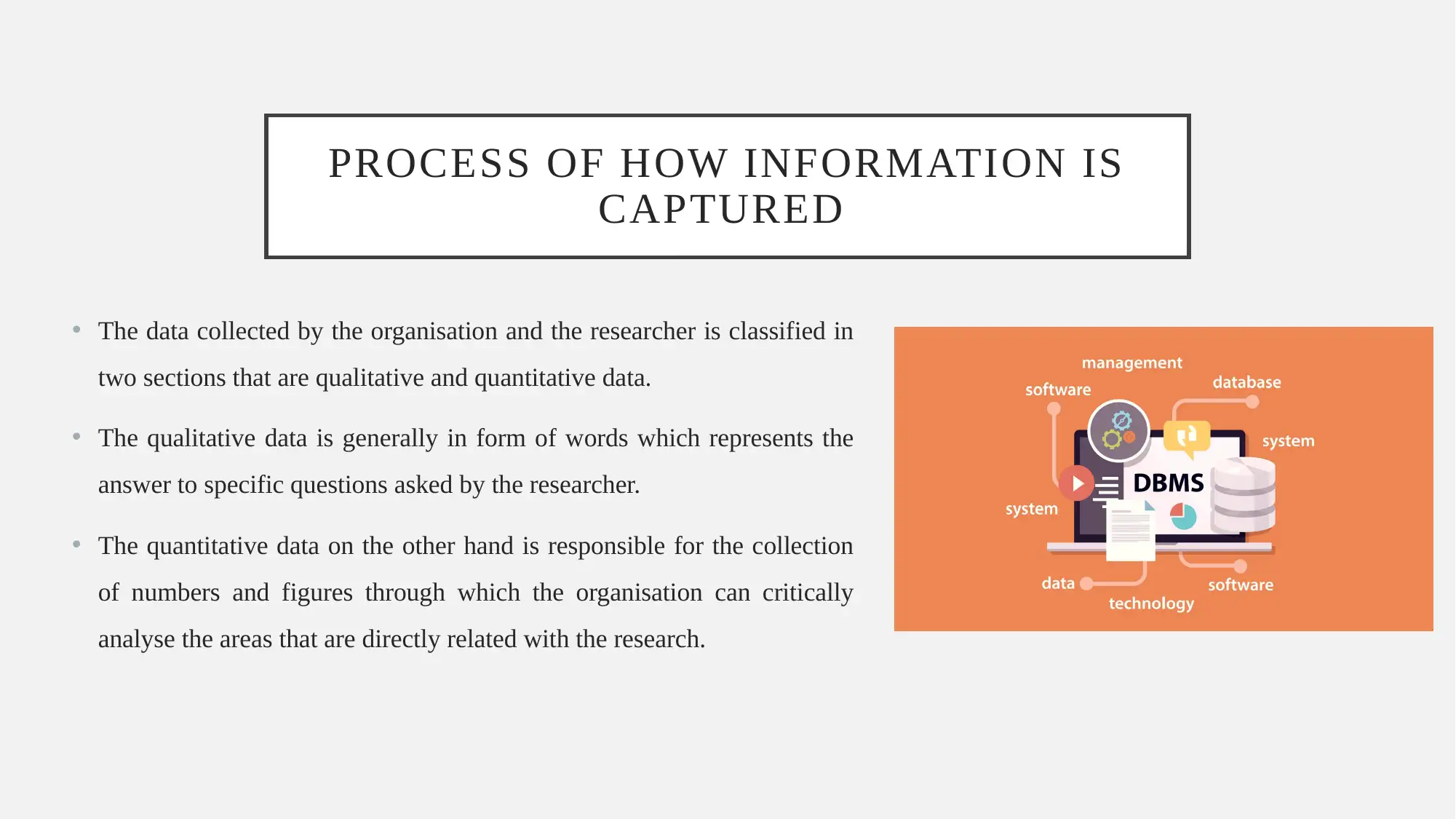
PROCESS OF HOW INFORMATION IS
CAPTURED
• The data collected by the organisation and the researcher is classified in
two sections that are qualitative and quantitative data.
• The qualitative data is generally in form of words which represents the
answer to specific questions asked by the researcher.
• The quantitative data on the other hand is responsible for the collection
of numbers and figures through which the organisation can critically
analyse the areas that are directly related with the research.
CAPTURED
• The data collected by the organisation and the researcher is classified in
two sections that are qualitative and quantitative data.
• The qualitative data is generally in form of words which represents the
answer to specific questions asked by the researcher.
• The quantitative data on the other hand is responsible for the collection
of numbers and figures through which the organisation can critically
analyse the areas that are directly related with the research.
⊘ This is a preview!⊘
Do you want full access?
Subscribe today to unlock all pages.

Trusted by 1+ million students worldwide
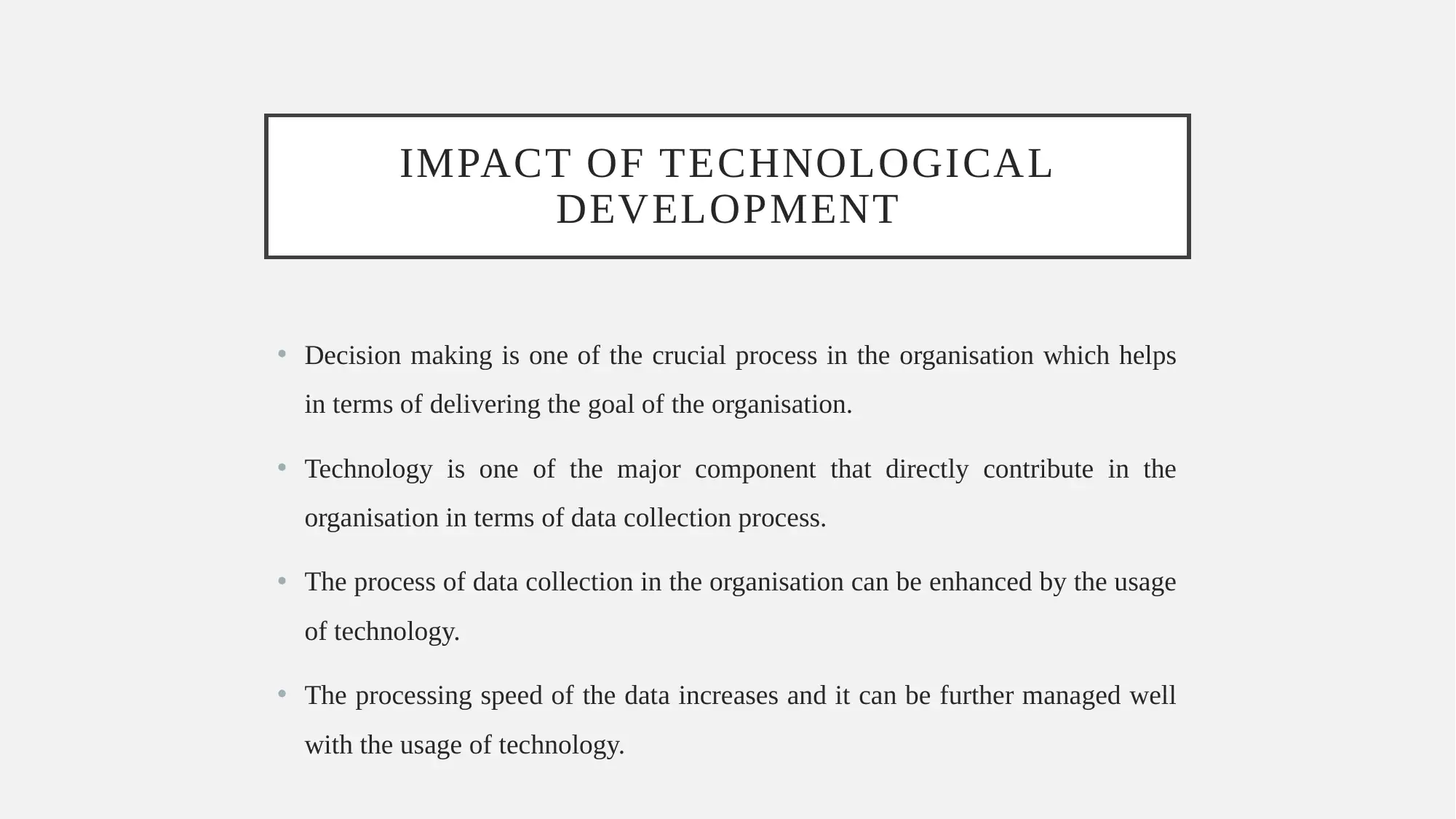
IMPACT OF TECHNOLOGICAL
DEVELOPMENT
• Decision making is one of the crucial process in the organisation which helps
in terms of delivering the goal of the organisation.
• Technology is one of the major component that directly contribute in the
organisation in terms of data collection process.
• The process of data collection in the organisation can be enhanced by the usage
of technology.
• The processing speed of the data increases and it can be further managed well
with the usage of technology.
DEVELOPMENT
• Decision making is one of the crucial process in the organisation which helps
in terms of delivering the goal of the organisation.
• Technology is one of the major component that directly contribute in the
organisation in terms of data collection process.
• The process of data collection in the organisation can be enhanced by the usage
of technology.
• The processing speed of the data increases and it can be further managed well
with the usage of technology.
Paraphrase This Document
Need a fresh take? Get an instant paraphrase of this document with our AI Paraphraser
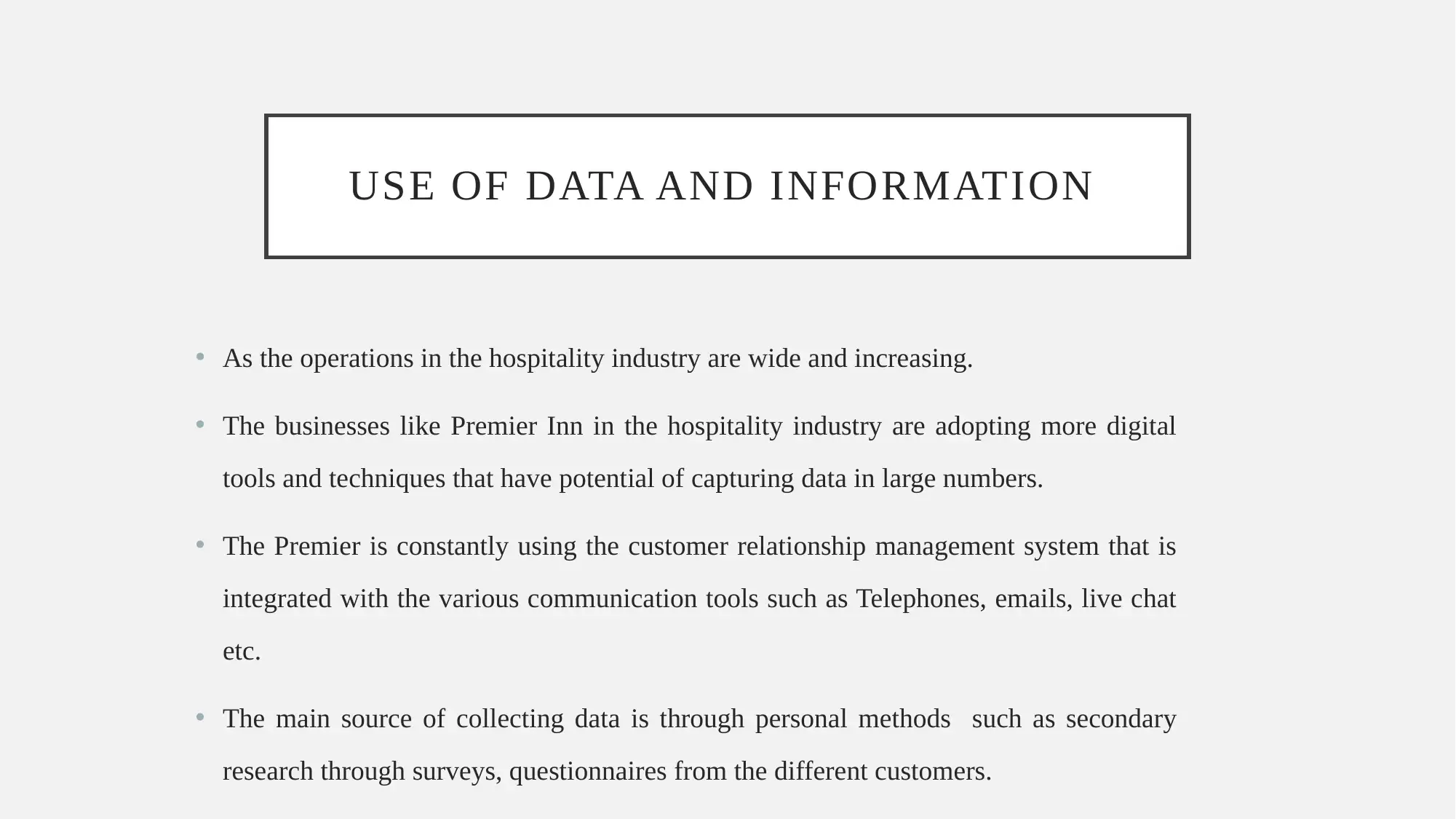
USE OF DATA AND INFORMATION
• As the operations in the hospitality industry are wide and increasing.
• The businesses like Premier Inn in the hospitality industry are adopting more digital
tools and techniques that have potential of capturing data in large numbers.
• The Premier is constantly using the customer relationship management system that is
integrated with the various communication tools such as Telephones, emails, live chat
etc.
• The main source of collecting data is through personal methods such as secondary
research through surveys, questionnaires from the different customers.
• As the operations in the hospitality industry are wide and increasing.
• The businesses like Premier Inn in the hospitality industry are adopting more digital
tools and techniques that have potential of capturing data in large numbers.
• The Premier is constantly using the customer relationship management system that is
integrated with the various communication tools such as Telephones, emails, live chat
etc.
• The main source of collecting data is through personal methods such as secondary
research through surveys, questionnaires from the different customers.
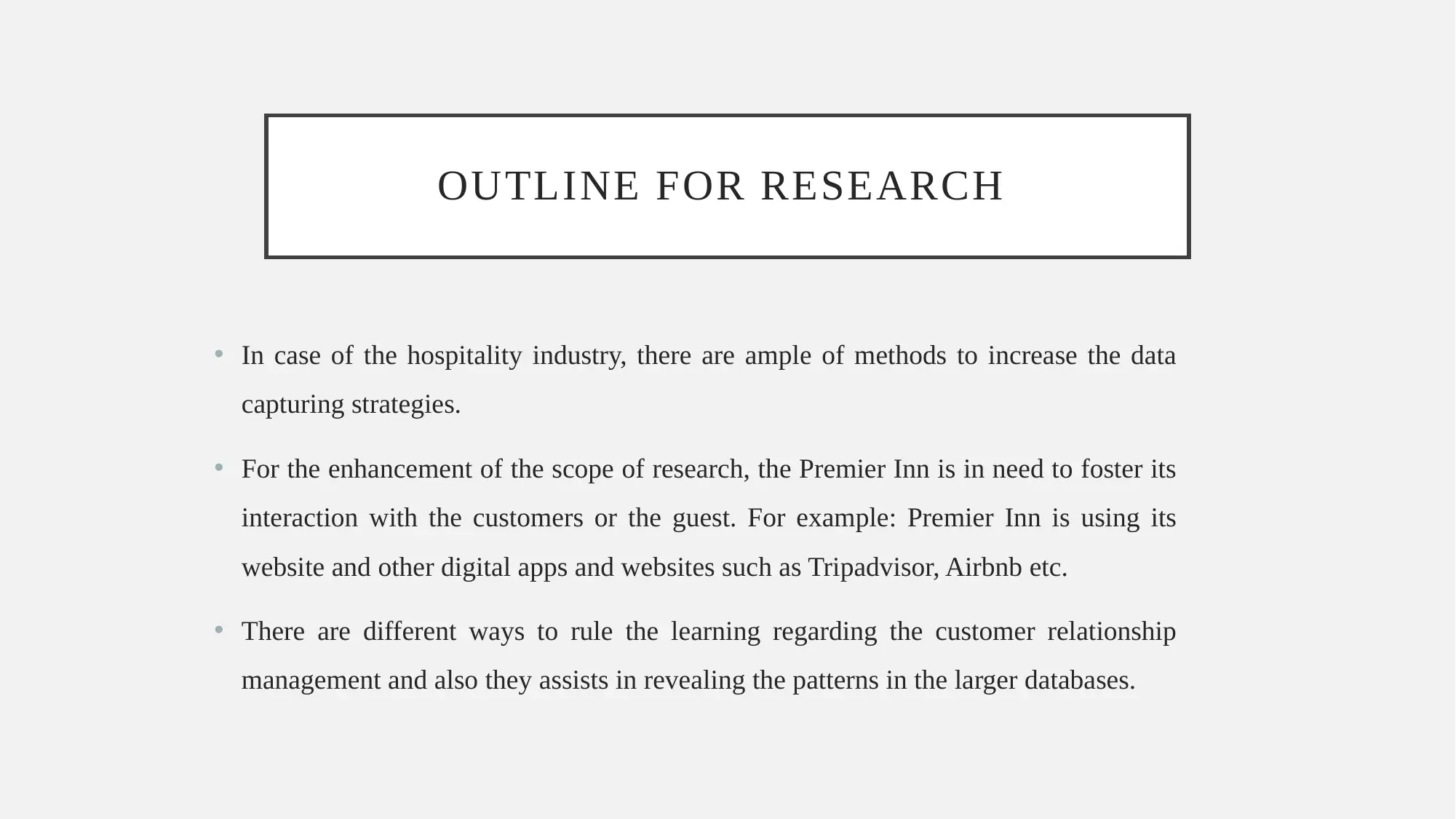
OUTLINE FOR RESEARCH
• In case of the hospitality industry, there are ample of methods to increase the data
capturing strategies.
• For the enhancement of the scope of research, the Premier Inn is in need to foster its
interaction with the customers or the guest. For example: Premier Inn is using its
website and other digital apps and websites such as Tripadvisor, Airbnb etc.
• There are different ways to rule the learning regarding the customer relationship
management and also they assists in revealing the patterns in the larger databases.
• In case of the hospitality industry, there are ample of methods to increase the data
capturing strategies.
• For the enhancement of the scope of research, the Premier Inn is in need to foster its
interaction with the customers or the guest. For example: Premier Inn is using its
website and other digital apps and websites such as Tripadvisor, Airbnb etc.
• There are different ways to rule the learning regarding the customer relationship
management and also they assists in revealing the patterns in the larger databases.
⊘ This is a preview!⊘
Do you want full access?
Subscribe today to unlock all pages.

Trusted by 1+ million students worldwide
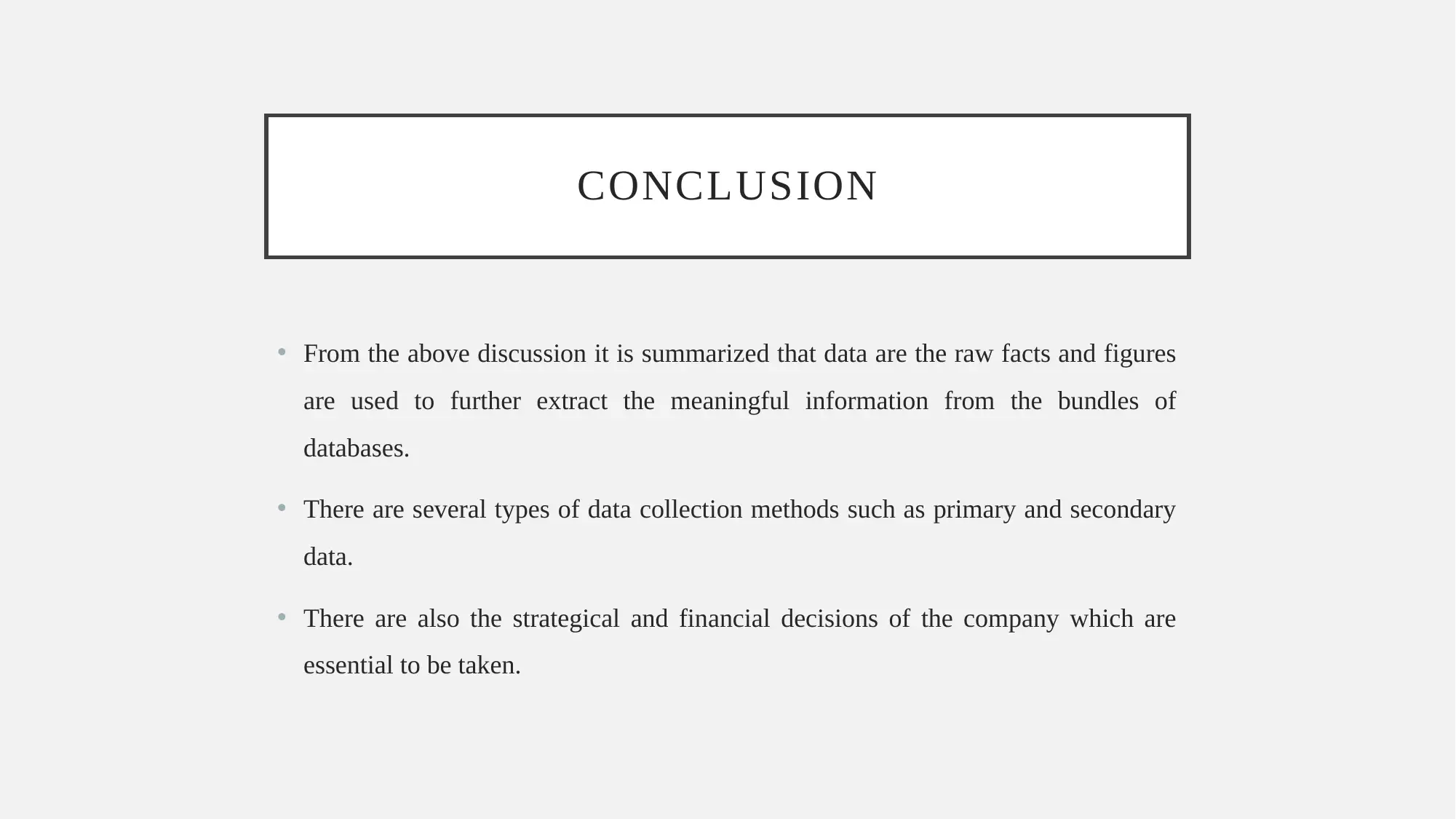
CONCLUSION
• From the above discussion it is summarized that data are the raw facts and figures
are used to further extract the meaningful information from the bundles of
databases.
• There are several types of data collection methods such as primary and secondary
data.
• There are also the strategical and financial decisions of the company which are
essential to be taken.
• From the above discussion it is summarized that data are the raw facts and figures
are used to further extract the meaningful information from the bundles of
databases.
• There are several types of data collection methods such as primary and secondary
data.
• There are also the strategical and financial decisions of the company which are
essential to be taken.
Paraphrase This Document
Need a fresh take? Get an instant paraphrase of this document with our AI Paraphraser
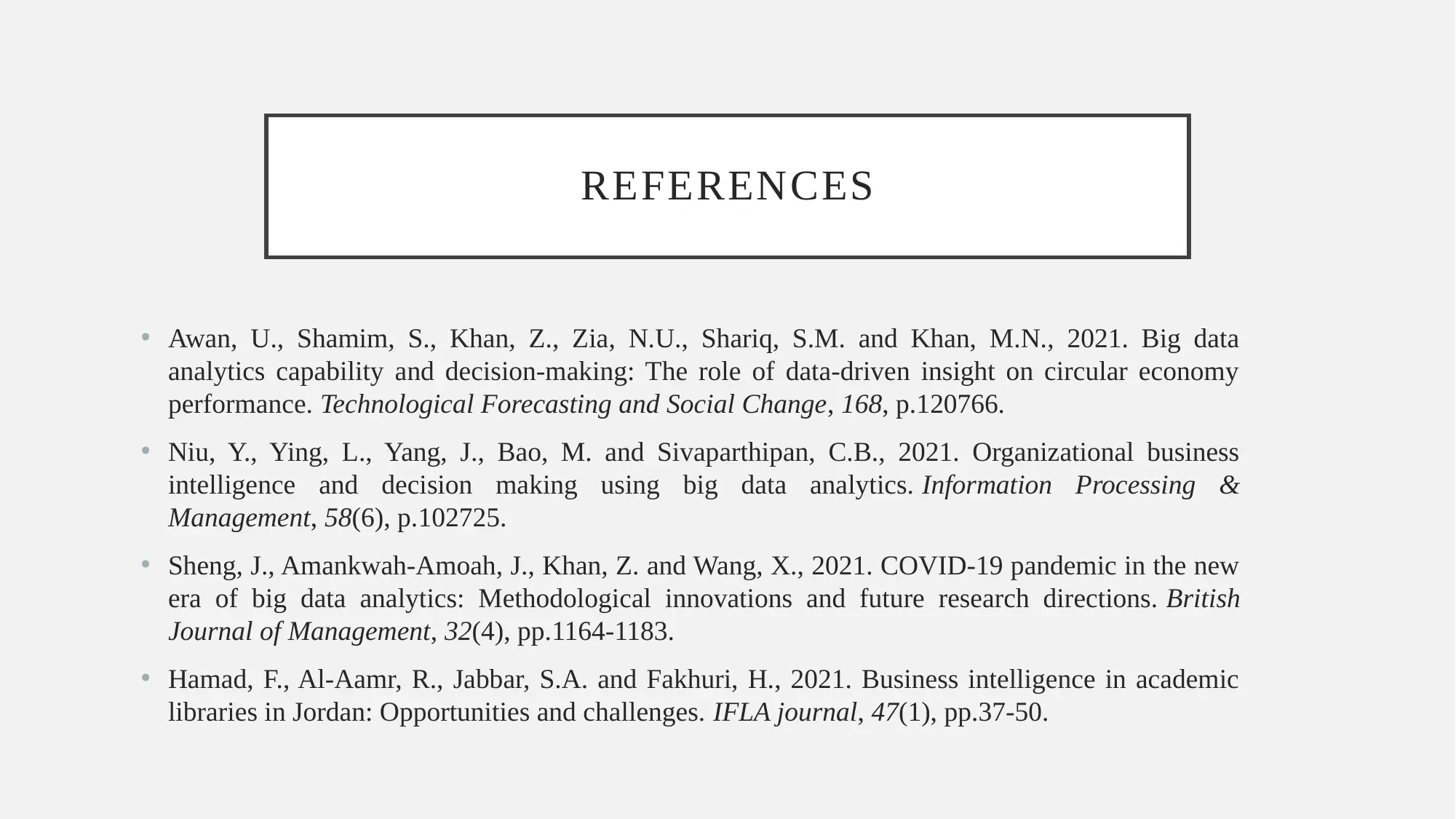
REFERENCES
• Awan, U., Shamim, S., Khan, Z., Zia, N.U., Shariq, S.M. and Khan, M.N., 2021. Big data
analytics capability and decision-making: The role of data-driven insight on circular economy
performance. Technological Forecasting and Social Change, 168, p.120766.
• Niu, Y., Ying, L., Yang, J., Bao, M. and Sivaparthipan, C.B., 2021. Organizational business
intelligence and decision making using big data analytics. Information Processing &
Management, 58(6), p.102725.
• Sheng, J., Amankwah‐Amoah, J., Khan, Z. and Wang, X., 2021. COVID‐19 pandemic in the new
era of big data analytics: Methodological innovations and future research directions. British
Journal of Management, 32(4), pp.1164-1183.
• Hamad, F., Al-Aamr, R., Jabbar, S.A. and Fakhuri, H., 2021. Business intelligence in academic
libraries in Jordan: Opportunities and challenges. IFLA journal, 47(1), pp.37-50.
• Awan, U., Shamim, S., Khan, Z., Zia, N.U., Shariq, S.M. and Khan, M.N., 2021. Big data
analytics capability and decision-making: The role of data-driven insight on circular economy
performance. Technological Forecasting and Social Change, 168, p.120766.
• Niu, Y., Ying, L., Yang, J., Bao, M. and Sivaparthipan, C.B., 2021. Organizational business
intelligence and decision making using big data analytics. Information Processing &
Management, 58(6), p.102725.
• Sheng, J., Amankwah‐Amoah, J., Khan, Z. and Wang, X., 2021. COVID‐19 pandemic in the new
era of big data analytics: Methodological innovations and future research directions. British
Journal of Management, 32(4), pp.1164-1183.
• Hamad, F., Al-Aamr, R., Jabbar, S.A. and Fakhuri, H., 2021. Business intelligence in academic
libraries in Jordan: Opportunities and challenges. IFLA journal, 47(1), pp.37-50.
1 out of 11
Related Documents
Your All-in-One AI-Powered Toolkit for Academic Success.
+13062052269
info@desklib.com
Available 24*7 on WhatsApp / Email
![[object Object]](/_next/static/media/star-bottom.7253800d.svg)
Unlock your academic potential
Copyright © 2020–2025 A2Z Services. All Rights Reserved. Developed and managed by ZUCOL.
